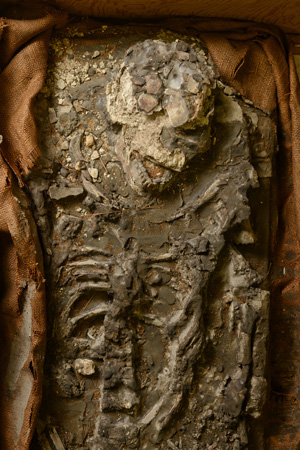Rare 6,500-Year-Old Skeleton Moves to Public View
The Penn Museum Invites Visitors to Share in Recent "Re-Discovery"
Rare 6,500-Year-Old Skeleton from Ur Excavation Site in Iraq
Moves to "In the Artifact Lab" Conservation Project Space Saturday, August 30
 PHILADELPHIA, PA AUGUST 2014—Following an early August announcement of a "rediscovered" find in a Physical Anthropology storage room—a rare, fragile, but largely intact 6,500-year-old human skeleton from the famous Ur excavations in what is now Iraq—the Penn Museum will be moving the skeleton to a public space beginning Saturday, August 30.
PHILADELPHIA, PA AUGUST 2014—Following an early August announcement of a "rediscovered" find in a Physical Anthropology storage room—a rare, fragile, but largely intact 6,500-year-old human skeleton from the famous Ur excavations in what is now Iraq—the Penn Museum will be moving the skeleton to a public space beginning Saturday, August 30.
Media throughout America, Europe, Asia, and Australia picked up on the story of the rediscovery—made possible via a digital documentation project that led to the positive identification of the ancient skeleton in a Museum storage room.
"Our goal as a museum and research institution is to share what we love with the public—the thrill of discovery, or in this case, the thrill of re-discovery," said Julian Siggers, the Penn Museum Williams Director. "Exploring and investigating our shared human past, whether it be in the field, in the lab, in the archives, or in storage, is what makes the field of archaeology and anthropology so exciting for us. We hope our visitors can join us as we make these fascinating connections."
The Ur skeleton will be transported from storage to the Museum's popular, ongoing In the Artifact Lab. Part exhibition gallery, part working laboratory, In the Artifact Lab invites visitors to watch Museum conservators at work on ancient Egyptian mummies—as well as artifacts from the Egyptian Section and other collections. The Ur skeleton will be on partial view while on a working table inside the glass-enclosed lab space, with some images and information provided on a video screen. As soon as conservators complete their work documenting, cleaning, and stabilizing the skeleton, it will move to a display case in front of the lab; then visitors will have an opportunity to get a very up-close view.
Conservators estimate that the skeleton will be ready to move to the case by late September (date to be posted on the Museum website when known); the skeleton will stay on view through Saturday, October 18, when the Museum celebrates International Archaeology Day with a host of family activities and a chance to visit the new Center for the Analysis of Archaeological Materials.
Opportunity to Learn More
While the skeleton is inside In the Artifact Lab and later on display, visitors will have frequent opportunities to meet with a physical anthropologist or informed physical anthropology student to ask questions. Now through International Archaeology Day on October 18, a physical anthropologist or student will be on hand every Saturday and Sunday from 1:00 to 2:00 pm to speak with visitors about the skeleton.
Also for those who want to find out more, Dr. William Hafford, Ur Digitization Project Manager, posted a blog entry on Beyond the Gallery Walls, the Penn Museum's blog, with additional information about the skeleton and its history.
The Penn Museum (the University of Pennsylvania Museum of Archaeology and Anthropology) is dedicated to the study and understanding of human history and diversity. Founded in 1887, the Museum has sent more than 300 archaeological and anthropological expeditions to all the inhabited continents of the world. With an active exhibition schedule and educational programming for children and adults, the Museum offers the public an opportunity to share in the ongoing discovery of humankind's collective heritage.
The Penn Museum is located at 3260 South Street, Philadelphia, PA 19104 (on Penn's campus, across from Franklin Field). Public transportation to the Museum is available via SEPTA's Regional Rail Line at University City Station; the Market-Frankford Subway Line at 34th Street Station; trolley routes 11, 13, 34, and 36; and bus routes 21, 30, 40, and 42. Museum hours are Tuesday through Sunday, 10:00 am to 5:00 pm, and first Wednesdays of each month until 8:00 pm, with P.M. @ PENN MUSEUM evening programs offered. Closed Mondays and holidays. Admission donation is $15 for adults; $13 for senior citizens (65 and above); free for U.S. Military; $10 for children and full-time students with ID; free to Members, PennCard holders, and children 5 and younger.
Hot and cold meals and light refreshments are offered to visitors with or without Museum admission in The Pepper Mill Café; the Museum Shop and Pyramid Shop for Children offer a wide selection of gifts, books, games, clothing and jewelry. Penn Museum can be found on the web at www.penn.museum. For general information call 215.898.4000. For group tour information call 215.746.8183.
###
About the Penn Museum
The Penn Museum’s mission is to be a center for inquiry and the ongoing exploration of humanity for our University of Pennsylvania, regional, national, and global communities, following ethical standards and practices.
Through conducting research, stewarding collections, creating learning opportunities, sharing stories, and creating experiences that expand access to archaeology and anthropology, the Museum builds empathy and connections across diverse cultures
The Penn Museum is open Tuesday-Sunday, 10:00 am-5:00 pm. It is open until 8:00 pm on first Wednesdays of the month. The Café is open Tuesday-Thursday, 9:00 am-3:00 pm and Friday and Saturday, 10:00 am-3:00 pm. On Sundays, the Café is open 10:30 am-2:30 pm. For information, visit penn.museum, call 215.898.4000, or follow @PennMuseum on social media.



